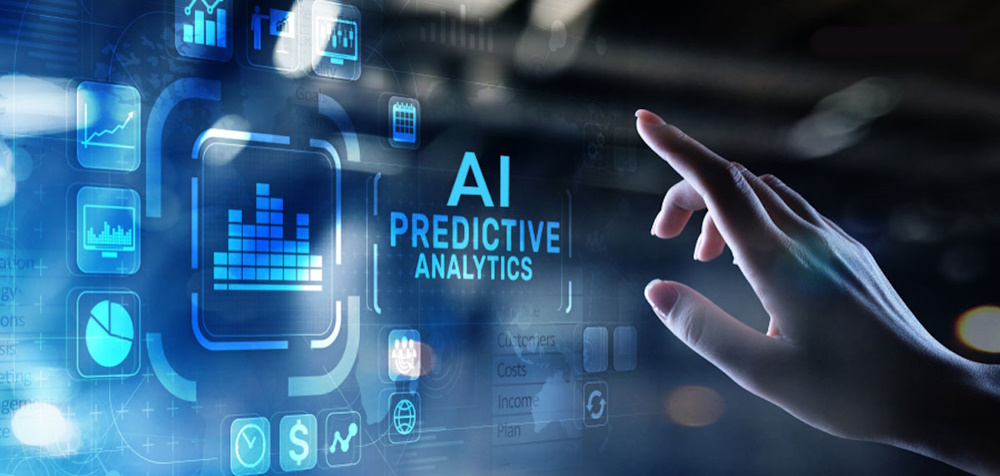 Predictive AI
Predictive AI
Identifies patterns in data and forecasts future events
Predictive AI is a powerful technology that uses statistical analysis and machine learning to identify patterns in data and forecast future behaviors or events. For example, businesses use predictive AI to forecast consumer behavior, optimize supply chains, and prevent equipment failures. The accuracy of these predictions depends on the quality and quantity of the data used to train the AI models.
Predictive AI is transforming industries by enabling businesses to anticipate future trends, optimize operations, and make informed decisions based on analyses obtained from historical and real-time data. It is one of the most impactful ways AI is changing companies and organizations by making systems and applications smarter, more proactive, and better aligned with the needs of businesses and society. Predictive AI is used for applications like forecasting customer behavior, anticipating equipment failures, predicting market trends, and many more. Like AI in general, predictive AI is continuously evolving, with research aimed at improving the accuracy of models and data, reducing bias, and enhancing the interpretability of AI models.

 Benefits of Predictive AI
Benefits of Predictive AI
- Proactive risk management and fraud detection.
- Optimized maintenance schedules and reduced downtime.
- Improved decision-making through data-driven insights which provides analytics that enable informed choices.
- Cost savings by helping to reduce waste, optimize resource allocation, and prevent costly failures.
- Streamlines operations by proactively predicting and addressing bottlenecks or issues.
- Enhanced operational efficiency and resource allocation.
- Personalizing user experiences by predicting and catering to individual preferences.
 Applications of Predictive AI
Applications of Predictive AI
Companies and organizations use predictive AI to identify risks and opportunities
Here are some examples from the growing list of applications:
- Automotive, Transportation, and Logistics: Optimizing deliver routes, predicting traffic patterns, maintenance schedules for vehicles.
- Customer Behavior: Predicting purchase patterns and making personalizing recommendations.
- Demand Forecasting: Estimating production needs based on market trends.
- Energy Sector Load Forecasting: Predicting energy consumption for efficient grid management.
- Finance: Credit scoring, fraud detection, predicting loan default risks or credit card fraud.
- Healthcare: Predicting patient outcomes such as the likelihood of complications or recovery times, disease trends, readmission risk prediction, the effectiveness of treatments.
- Inventory Management: Anticipating stock shortages or excess.
- Investments: Analyzing historical trends to forecast stock market behavior and algorithmic trading.
- Manufacturing: Predictive maintenance to foresee equipment failures and supply chain optimization.
- Marketing: Customer segmentation, churn prediction, and targeted advertising.
- Predicting Disease Outbreaks: Analyzing patient and environmental data to forecast disease trends.
- Predictive Maintenance: Reducing downtime by detecting potential machine failures before they happen.
- Renewable Energy: Optimizing wind and solar power generation predictions based on weather data.
- Retail and E-Commerce: Anticipating consumer behavior, demand forecasting, inventory management, and personalized marketing.

 Key Technologies Involved
Key Technologies Involved
- Machine Learning: Especially supervised learning for pattern recognition in data.
- Deep Learning: For complex pattern recognition in unstructured data like images or text.
- Statistical Analysis: For understanding data trends and making statistical predictions.
- Natural Language Processing: To predict text-based outcomes or in conversational AI.
Even though generative AI and predictive AI both fall under the AI umbrella, they are quite distinct. Generative AI is trained on large datasets containing millions of sample content, while predictive AI uses smaller, targeted datasets as input data. While both AI systems employ an element of prediction to produce their outputs, generative AI creates novel content whereas predictive AI forecasts future events and outcomes. Most generative AI models lack explainability, as it's often difficult or impossible to understand the decision-making processes behind their results. On the other hand, predictive AI estimates are more explainable because they're grounded on numbers and statistics.
 How It Works
How It Works
Machine learning algorithms to identify patterns and
vast amounts of specialized data
- Data Collection: Gathering large amounts of data from various sources including historical data and real-time data. Sources include IoT devices, databases, user interactions, and sensors.
- Data Preparation: Cleaning and preparing data for analysis. The data is preprocessed to remove inconsistencies, removing duplicates, fill missing values, and normalize formats to ensure that the AI model works with clean, accurate information.
- Feature Engineering: Relevant features or variables are selected and extracted from the data to represent the problem effectively. This process may involve techniques like dimensionality reduction, feature scaling, and encoding categorical variables.
- Model Training: Using algorithms to learn from the data in order to to make predictions about future events. The algorithms could involve regression models, decision trees, neural networks, etc. Models are updated periodically as new data becomes available, ensuring they stay relevant and accurate over time. Training also includes identifying the most relevant data features or attributes that influence predictions to enhance model accuracy.
- Validation: Testing the model with new data to ensure its performance and accuracy.
- Deployment: Integrating the model into systems where it can make live predictions.
- Prediction Generation: The trained model generates predictions based on new data inputs.
- Monitoring and Updating: Continuously updating the model with new data as it becomes available and refining the model based on its performance, ensuring they stay relevant and accurate over time.
 Challenges of Predictive AI
Challenges of Predictive AI
One of the key challenges of predictive AI is poor-quality data, which leads to inaccurate predictions. Incomplete or biased datasets can introduce errors. Predictive models, as they say, are only as good as the data they're trained on. Poor or biased data can lead to inaccurate predictions.
Another challenge is the ethics of predictive AI, since predictions can inadvertently reinforce biases in the data. Misuse of predictive AI, such as in surveillance or discriminatory decision-making, is a concern. Handling personal data raises many privacy concerns, and there's also the risk of models perpetuating biases from historical data.
In the book AI Snake Oil, the authors argue that predictive AI often has low accuracy because certain important factors are not available and that decision subjects have strong incentives to game the system.
Here are some other challenges in the use of predictive AI:
- Model Complexity: Building accurate models requires expertise in AI, machine learning, and data science.
- Overfitting: Models might perform well on training data, but fail in real-world scenarios if they're too tailored to the training set.
- Scalability: Implementing predictive AI in large-scale, real-time environments can be challenging.
- Interpretability: Advanced AI models, like deep learning, often act as black boxes, making it hard to explain why a c ertain prediction was made. Complex models like deep learning can be black boxes, making it hard to explain predictions.
 Future of Predictive AI
Future of Predictive AI
The growing adoption of IoT devices and 5G networks will enable predictive AI to provide real-time insights in industries like healthcare, smart cities, and autonomous vehicles. Advances in machine learning techniques and access to more diverse data will enhance predictive capabilities.
In the future, despite some differences, predictive AI may work in tandem with generative AI to not only forecast outcomes, but also recommend real solutions. We can expect more sophisticated personalization in everything from entertainment recommendations to medical treatments.
Because of some of the current ethical issues surrounding predictive AI, we can expect more AI regulations, increasing the focus on ethical AI, transparency, and regulatory compliance.
 Links
Links
ibm.com/think/topics/predictive-ai
coursera.org/articles/generative-ai-vs-predictive-ai
ibm.com/blog/generative-ai-vs-predictive-ai-whats-the-difference
cloudapps.com/a-complete-guide-to-predictive-ai-and-its-business-applications
cloudflare.com/learning/ai/what-is-predictive-ai
domo.com/glossary/ai-predictive-analytics
coveo.com/blog/generative-vs-predictive-ai
glean.com/blog/generative-predictive-differences-applications
verteego.com/en/what-is-predictive-ai
eweek.com/artificial-intelligence/generative-ai-vs-predictive-ai